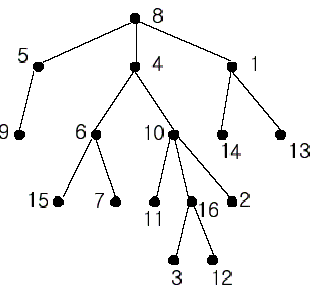| Time Limit: 1000MS | Memory Limit: 10000K | |
| Total Submissions: 19728 | Accepted: 10460 |
Description

In the figure, each node is labeled with an integer from {1, 2,...,16}. Node 8 is the root of the tree. Node x is an ancestor of node y if node x is in the path between the root and node y. For example, node 4 is an ancestor of node 16. Node 10 is also an ancestor of node 16. As a matter of fact, nodes 8, 4, 10, and 16 are the ancestors of node 16. Remember that a node is an ancestor of itself. Nodes 8, 4, 6, and 7 are the ancestors of node 7. A node x is called a common ancestor of two different nodes y and z if node x is an ancestor of node y and an ancestor of node z. Thus, nodes 8 and 4 are the common ancestors of nodes 16 and 7. A node x is called the nearest common ancestor of nodes y and z if x is a common ancestor of y and z and nearest to y and z among their common ancestors. Hence, the nearest common ancestor of nodes 16 and 7 is node 4. Node 4 is nearer to nodes 16 and 7 than node 8 is.
For other examples, the nearest common ancestor of nodes 2 and 3 is node 10, the nearest common ancestor of nodes 6 and 13 is node 8, and the nearest common ancestor of nodes 4 and 12 is node 4. In the last example, if y is an ancestor of z, then the nearest common ancestor of y and z is y.
Write a program that finds the nearest common ancestor of two distinct nodes in a tree.
Input
Output
Sample Input
2 16 1 14 8 5 10 16 5 9 4 6 8 4 4 10 1 13 6 15 10 11 6 7 10 2 16 3 8 1 16 12 16 7 5 2 3 3 4 3 1 1 5 3 5
Sample Output
4 3
Source
本题是一个多叉树,然后求两点的最近公共单亲节点。
就是典型的LCA问题。这是一个很多解法的,而且被研究的很透彻的问题。
原始的解法:从根节点往下搜索,若果搜索到两个节点分别在一个节点的两边,那么这个点就是最近公共单亲节点了。
Trajan离线算法:首次找到两个节点的时候,如果记录了他们的最低单亲节点,那么答案就是这个最低的单亲节点了。
问题是如何有效记录这个最低单亲节点,并有效根据遍历的情况更新,这就是利用Union Find(并查集)记录已经找到的节点,并及时更新最新访问的节点的当前最低单亲节点。
就是并查集的灵活运用啦,如果学会了并查集那么学这个算法是不难的了。
2015-1-24 update:
下面括号的分析好像有点问题:
(下面是简单思路差不多是暴力法的解法,不过其实相对本题来说就是一次查询,故此这个也是不错的方法,而且平均时间效率不过O(lgn),应该是很快的了。
不过有思想和这个差不多的,但是更加省内存的方法,就是从需要查找的节点往单亲节点查找,那么速度是一样的,不过省内存,因为只需要记录一个父母节点就可以了,而且程序会简洁点。)
这个方法的基本思想是:
假设要查找u,v的LCA,
递归深度遍历整棵树,这个时候有三种情况:
1. 如果没哟找到u或者v其中一个节点,那么就返回0;
2 如果找到了u或v的其中一个节点,那么就返回找到的节点
3 如果找到u且找到v两个节点,那么就返回其父母节点,而这个父母节点正好是LCA,为什么呢?因为这个是逐层递归上去的算法,只有在u和v的分叉节点能找到两个非零返回值,其他情况都只能找到一个或者0个非零返回值。巧妙地利用了递归的特点,把LCA作为了最终的返回值。
因为最坏情况需要递归整棵树,故此这个算法的时间效率其实是O(n),n为整棵树的节点数。故此本算法虽然AC了,但是其实时间效率还是蛮低的。
之前分析说是O(lgn)是不对的,不好意思,如果误导了某些读者,那么表示抱歉。还好下面算法是没错的。
本算法对递归的理解还是要求挺高的,对于初学者还是有点难度。
int const MAX_N = 10001;
struct Node
{
bool notRoot;
vector<int> children;
};
Node Tree[MAX_N];
int N;
int find(int r, int lNode, int rNode)
{
if (!r) return 0;
if (r == lNode) return r;
if (r == rNode) return r;
vector<int> found;
for (int i = 0; i < (int)Tree[r].children.size(); i++)
{
found.push_back(find(Tree[r].children[i], lNode, rNode));
}
int u = 0, v = 0;
for (int i = 0; i < (int)found.size(); i++)
{
if (found[i] != 0)
{
if (u) v = found[i];
else u = found[i];
}
}
if (v) return r;
return u;
}
void solve()
{
scanf("%d", &N);
memset(Tree, 0, sizeof(Tree));
int u, v;
for (int i = 1; i < N; i++)
{
scanf("%d %d", &u, &v);
Tree[u].children.push_back(v);
Tree[v].notRoot = 1;
}
int root = 0;
for (int i = 1; i <= N; i++)
{
if (!Tree[i].notRoot)
{
root = i;
break;
}
}
scanf("%d %d", &u, &v);
int r = find(root, u, v);
printf("%d\n", r);//if (lin && rin) 必然是存在点,故此无需判断
}
int main()
{
int T;
scanf("%d", &T);
while (T--)
{
solve();
}
return 0;
}下面是Tarjan离线算法,效率应该和上面是一样的,多次查询的时候就能提高效率。不过实际运行比上面快。
#include <stdio.h>
#include <string.h>
#include <vector>
using std::vector;
int const MAX_N = 10001;
struct Node
{
bool notRoot;
bool vis;
vector<int> children;
};
Node Tree[MAX_N];
int N;
int u, v;
int parent[MAX_N];
inline int find(int x)
{
if (!parent[x]) return x;
return parent[x] = find(parent[x]);
}
inline void unionTwo(int p, int x)
{
p = find(p);
x = find(x);
if (p == x) return ;
parent[x] = p;
}
bool LCATarjan(int root)
{
Tree[root].vis = true;
if (root == u && Tree[v].vis == true)
{
printf("%d\n", find(v));
return true;
}
if (root == v && Tree[u].vis == true)
{
printf("%d\n", find(u));
return true;
}
for (int i = 0; i < (int)Tree[root].children.size(); i++)
{
if (LCATarjan(Tree[root].children[i])) return true;
unionTwo(root, Tree[root].children[i]);
}
return false;
}
void solve()
{
scanf("%d", &N);
memset(Tree, 0, sizeof(Tree));
memset(parent, 0, sizeof(parent));
for (int i = 1; i < N; i++)
{
scanf("%d %d", &u, &v);
Tree[u].children.push_back(v);
Tree[v].notRoot = 1;
}
int root = 0;
for (int i = 1; i <= N; i++)
{
if (!Tree[i].notRoot)
{
root = i;
break;
}
}
scanf("%d %d", &u, &v);
LCATarjan(root);
}
int main()
{
int T;
scanf("%d", &T);
while (T--)
{
solve();
}
return 0;
}






















 101
101











 被折叠的 条评论
为什么被折叠?
被折叠的 条评论
为什么被折叠?








